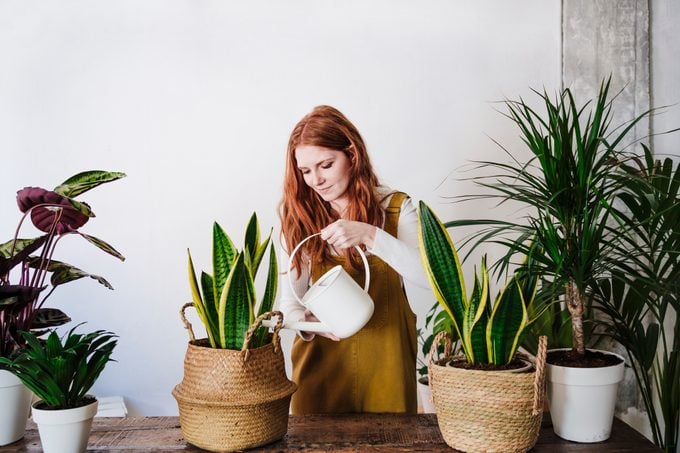You’ve Been Watering Indoor Plants the Wrong Way—Here’s What to Do Instead
Updated: Sep. 20, 2022
Hint: Step away from the tap water.
Are You Watering Your Indoor Plant Properly?

If you have a single potted succulent on the windowsill, or a room full of houseplants, it’s important to know how to care for them. Of course, proper watering is one of the most important basics all plant parents need to know. Are you watering your indoor plant the right way? Here’s what our garden expert has to say.
Check out the best watering cans for every garden.
Stop Watering Your Indoor Plant With Tap Water
“I read that fluoride in tap water can turn leaf tips brown. Is this true? If so, is my only solution to catch and store rainwater?” asks Birds & Blooms reader Gail Powell of Homerville, Ohio.
Melinda Myers responds, “Dracaena, spider plants, ti plants, prayer plants, palms and some others tend to be sensitive to the chloride and fluoride in tap water. Rainwater and distilled water are two alternatives; I use water from my dehumidifier for these plants. When none of these is available, keeping the soil slightly moist helps to prevent the brown tips.”
Birds & Blooms reader Sharon Woodworth of Georgetown, Kentucky, agrees. “Collect rainwater and use it on your houseplants. I’ve been doing it for years!”
Learn how to get rid of indoor plant bugs.
Why Are My Palm Leaves Turning Brown?

“What’s wrong with my indoor palm tree,” asks Brenda Nelson of Shakopee, Minnesota.
Melinda says, “Browning tips on houseplant leaves can result from inconsistent watering, salt buildup in the soil or fluoride damage. Water your palm thoroughly when the top inch of soil is starting to dry, then pour the excess water out of the saucer. You can also place pebbles in the saucer so the pot sits above the excess water that collects in the pebbles. As the moisture evaporates, it increases the humidity around the plant.
Try leaching the soil in case it has a buildup of mineral salts from fertilizer and water. Scrape off any crusty white salts that may have accumulated on the soil surface or the edge of the pot. Water thoroughly, allowing the excess to drain out of the container. Repeat two more times.
Finally, certain plants—including palms, ti plants, spider plants, dracaenas and prayer plants—are sensitive to the fluoride in tap water. Too much of the chemical can cause browning similar to your plant’s. Consider watering your palm with distilled water or rainwater.”
When is the best time to water plants?
More Indoor Plant Watering Tips
Avoid using hard water and use water that is room temperature for best results.
Next, check out 15 ways to conserve water in the garden.




















